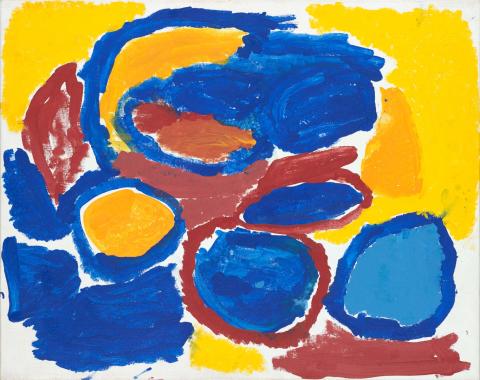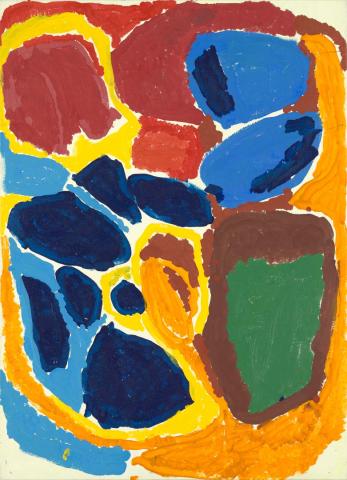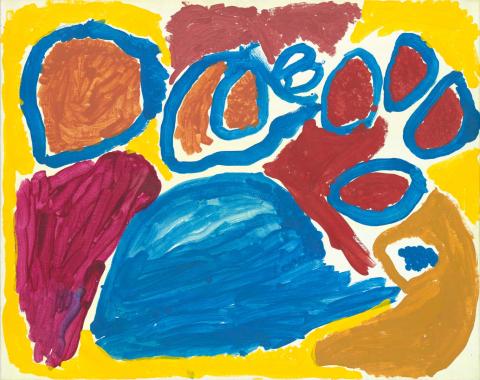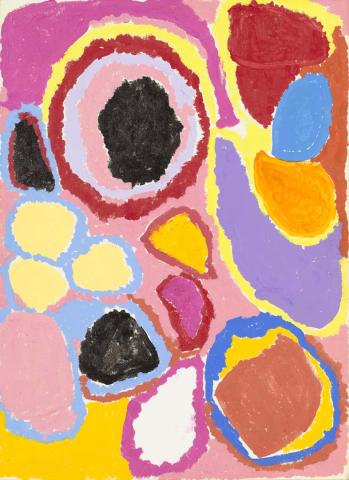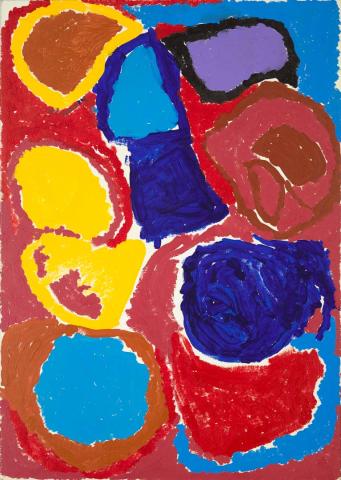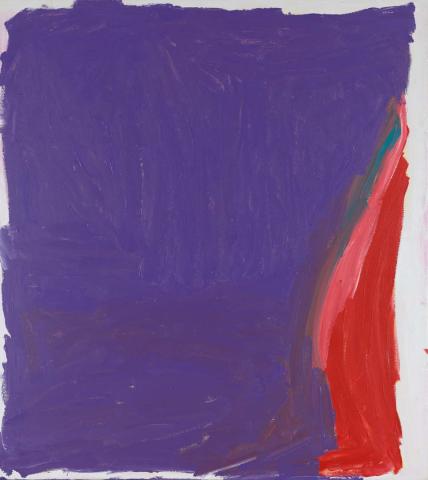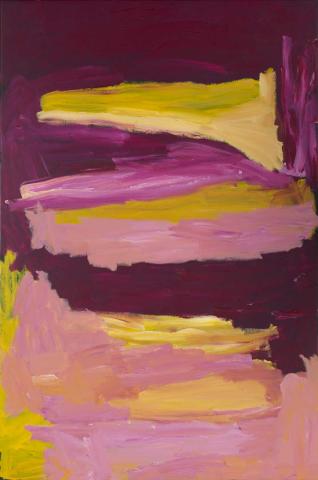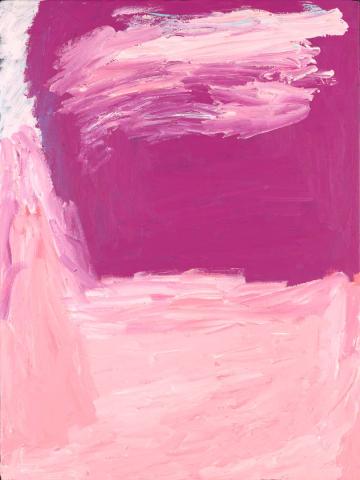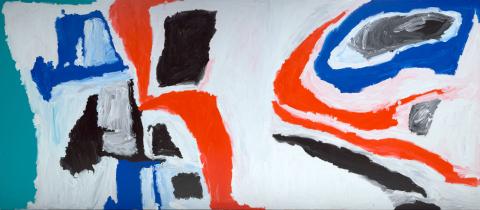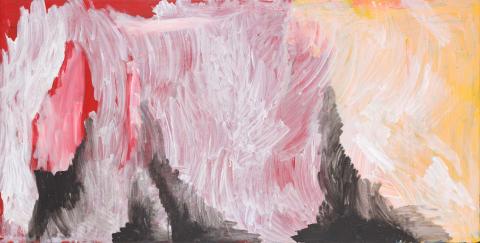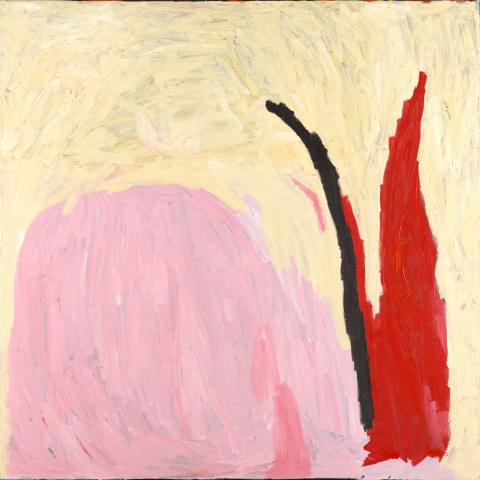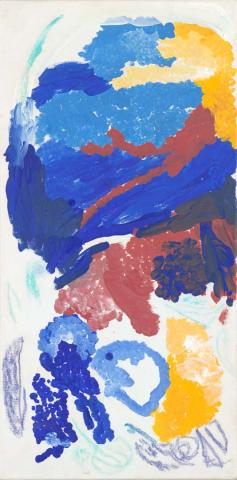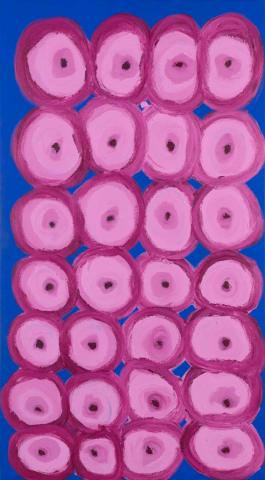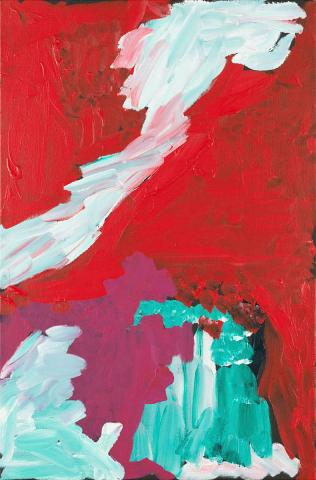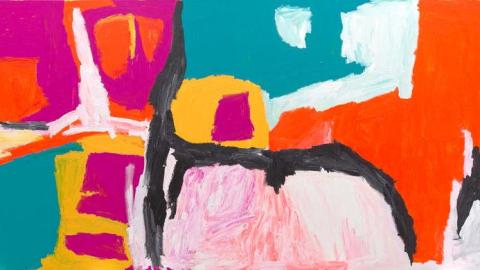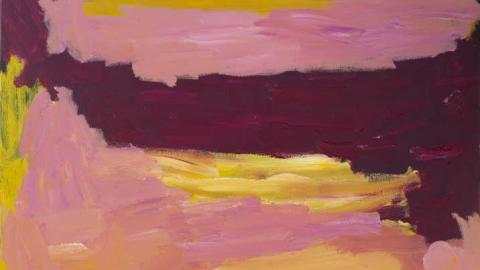Mirdidingkingathi Juwarnda Sally Gabori was one of the most important contemporary Australian artists working through the 2000s and 2010s and the most feted of community-based artists from Queensland. This group of works is a truly significant collection which was gifted to the Gallery for the people of Queensland by the Estate of Mirdidingkingathi Juwarnda Sally Gabori. The works in this group add to the Gallery's own holdings in creating a comprehensive representation of the artist's career, from her very first painting to her final work.
Sally’s brief but potent journey as an artist began in 2005, at the age of 81 when the local art centre on Mornington Island, in association with Woolloongabba Art Gallery, Brisbane, held painting workshops led by Simon Turner to revive the once vibrant art-making community. My Country 2005 is Gabori’s very first painting, produced at the first of these community painting workshops, and conveys an artist’s first attempt to capture what is familiar in an entirely new way. Depicting her birthplace at Mirdidingki, vibrant forms, shapes and outbreaks emerge from the uncharacteristically unpainted white canvas background. Although somewhat experimental, this work showed all the potential of what would come, and senior local Lardil artist Melville Escott, followed by the workshop convenors, encouraged her early effort.
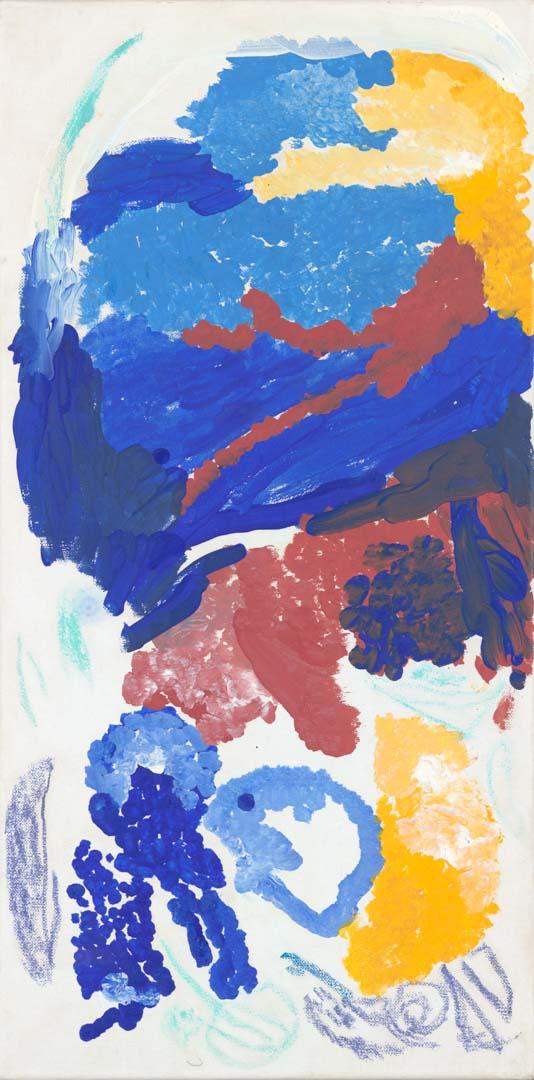
The next five works — My Country, My Father’s Country, My Father’s Country – Plenty Fish, Story Place – King Alfred’s Country and Dibirdibi Country 2005 — were all painted in the first few months of Sally’s painting career, a phase where she worked directly with Turner at regular workshops. These works feature places that would become the staple of her oeuvre: Thundi (Sally’s father’s Country); Makarrki (Sally’s brother’s Country); and Dibirdibi Country (Sally’s husband’s Country). They use similar mark making techniques to Sally's first work but evidence developments in her use of colour and space and in her overall confidence with brush and paint.
Mawunjuru – Big Mullet 2005 was also painted in the first year of Gabori’s career, and shows the emergence of a bold new style quite divergent to her earliest works based on specific sites. These works focussed on the schools of fish that abound in the waters of Bentinck Island, which were a key source of sustenance for Kaiadilt people for generations. Sally, as a young woman, was responsible for the maintenance of Ngurruwarr, the traditional rock-walled fish traps that have been in use for millennia on the island and abound at particular places along its coast. As the tide drops — sometimes over 16 feet — schools of fish become entrapped inside the walls of these rock pens. Gabori’s paintings from this period feature multiple roundels jostling side by side throughout their composition, envisioning the schools of fish frantically trashing, their bodies disturbing the lens of the rapidly draining water, as they realise they have become trapped.

My Country 2011 is from a group of similar concurrent paintings that all featured the same loose banded compositional elements. These works are thought to represent the progression of sandflats that emerge like a staircase from the bay facing Sally’s Country as the tide falls. Slight rises and falls in the flats trap slivers of water and — as the sun hits the water — they become dramatic contrasting strips of dark sand and shimmering water/light. Mirdidingki Creek is only evidenced at low tide in the bay by a small track, much less than a channel, which snakes its way through these intertidal sand ridges.
The overwhelming majority of Sally’s paintings focus on one theme and place — Dibirdibi Country. Her paintings of it are much more expansive and draw on a broader range of experiences and related places than do her other bodies of work. Dibirdibi Country is the Country of the Yuujbanda (Dreaming) Ancestor, Dibirdibi, the Rock Cod whose creative journey, as recounted by Kaiadilt people, accords with the geologically verifiable account of the creation of the South Wellesley Islands.
At the end of the last ice age, sea levels rose dramatically. The former Lake Carpentaria joined the Arafura Sea to the west and the Torres Strait to the east. The land surrounding the Wellesley Ridge became inundated, cutting off Bentinck Island from the mainland and from its neighbouring islands. Kaiadilt history commemorates this climatic episode — which occurred some 6000 years ago — through the story of Dibirdibi who thrashed about, cutting out channels with his ventral fins and carving the South Wellesley Islands off from one another. Dibirdibi’s creative and destructive journey ended at the high hill Bardathurr on Sweers Island, where he was caught and eaten. His liver was discarded, thrown at the sea’s edge below a cliff at the hill’s base, transforming into a freshwater spring that provides a reliable water source to this day.1
For Sally, ancestral story and intimate personal history overlap: her husband Pat Gabori was also called Dibirdibi as the inheritor of the story, song and associated places for Dibirdibi. Pat’s birthplace — his Country — is Kabararrji, which sits next to Sally’s Country at the mouth of the creek at Mirdidingki. In painting Dibirdibi Country, Sally may be referring to Pat’s birth Country or to the places he is associated with through ownership of that narrative cycle. Dibirdibi Country 2012 correlates most directly to the topography of and around Kabarrarrji. The area where the pink and yellow-white fields meet is a long arcing bay near the centre of the southern coastline of Bentinck Island, which comes to a point at its eastern edge. The black stripe is likely a small creek that flows through the point and to the east is Kabararrji, where the red section indicates a shift of the coastline toward the north. The very tip of this red field correlates with the site of Mirdidingki Creek, Sally’s birthplace, while the red section appears to mark the extent of the shallow sandflat and reef system that connects these sites together.
Other Dibirdibi works here that feature the use of white as a major element generally speak to the inland floodplains, which are often swollen rivers in the wet season and arid salt pans which shimmer in the hot northern dry season. Dibirdibi Country 2011 is part of a group of works that uses a thinned white paint washed over the underlying landscape composition to create a sense of depth. This technique was developed as Gabori advanced in age and her vigorous painting style was sometimes incompatible with thick acrylic paint — a thinner overwash in white allowed the artist to retain her free, gestural painting movement. The technique and its aesthetic also lent itself to certain places and phenomena, with many works from this period referencing the seasonal flux felt by the land: the cyclones, storms and winds felt at Thundi in the north-east of the island and the wet season inundation of the central salt pans (in Dibirdibi Country), or their glistening in the dry season sun.
Thundi 2013 is the final work ever painted by Mirdidingkingathi Juwarnda Sally Gabori. Many believed that Sally had stopped painting in 2012, after her move to Kuba Natha, Mornington Island’s aged care facility. In June 2013, however, she asked for materials to paint and produced a series of at least six works. These would be the last she would paint before she passed away in February 2015. The six works were inspired by Thundi, her father’s Country, and Dibirdibi Country, associated with her husband. These were also the main focus of Gabori’s earliest works and indicate the importance of these places and people, to her career and life.
Endnote:
- Details of Dibirdibi Story provided in an artist’s statement from Mirndiyan Gununa Mornington Island Art Centre, Dec. 2015.
Digital story context and navigation
DULKA WARNGIID – LAND OF ALLExplore the story
Related resources
